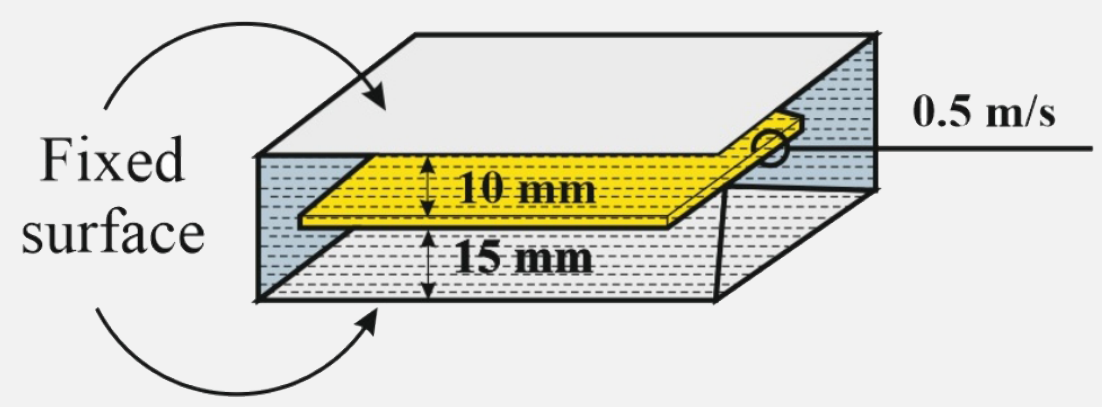flat plate is separated from a large plate by a layer of glycerine of thickness 3×10−3m. If the coefficient of viscosity of glycerine is2Ns/m2 what is the force required to keep the plate moving with a velocity of6×10−2m/s. Area of the plate is 4.8×10−3m
The correct Answer is:0.192N
To solve the problem, we will use the formula for the force required to keep a plate moving through a viscous fluid. The formula is given by:
F=η⋅A⋅dudy
Where:
- F is the force,
- η is the coefficient of viscosity,
- A is the area of the plate,
- dudy is the velocity gradient.
Step 1: Identify the given values
- Coefficient of viscosity (η) = 2Ns/m2
- Thickness of the glycerine layer (dy) = 3×10−3m
- Velocity of the plate (du) = 6×10−2m/s
- Area of the plate (A) = 4.8×10−3m2
Step 2: Calculate the velocity gradient (dudy)
The velocity gradient is calculated as:
dudy=dudy=6×10−23×10−3=20s−1
Step 3: Substitute the values into the formula
Now we will substitute the values into the formula for force:
F=η⋅A⋅dudy
Substituting the known values:
F=2⋅(4.8×10−3)⋅20
Step 4: Calculate the force
Now we perform the calculation:
F=2⋅4.8×10−3⋅20=0.192N
Final Answer
The force required to keep the plate moving is:
F=0.192N
- F is the force,
- η is the coefficient of viscosity,
- A is the area of the plate,
- dudy is the velocity gradient.
- Coefficient of viscosity (η) = 2Ns/m2
- Thickness of the glycerine layer (dy) = 3×10−3m
- Velocity of the plate (du) = 6×10−2m/s
- Area of the plate (A) = 4.8×10−3m2
The velocity gradient is calculated as:
Now we will substitute the values into the formula for force:
Now we perform the calculation:
The force required to keep the plate moving is:
Topper's Solved these Questions
- MOTION IN FLUIDS BOOK - ICSECHAPTER - MOTION IN FLUIDS EXERCISE - SELECTED PROBLEMS (FROM POISEUILLE.S FORMULA)
19 Videos
- MOTION IN FLUIDS BOOK - ICSECHAPTER - MOTION IN FLUIDS EXERCISE - SELECTED PROBLEMS ( FROM PRESSURE, ARCHIMEDES. PRINCIPLE)
7 Videos
- INTERNAL ENERGY BOOK - ICSECHAPTER - INTERNAL ENERGY EXERCISE - SELECTED PROBLEMS (FROM HEAT ENGINES)
21 Videos
- OSCILLATIONS BOOK - ICSECHAPTER - OSCILLATIONS EXERCISE - SELECTED PROBLEMS (OSCILLATION IN A TUNNEL BORED THROUGH THE EARTH)
2 Videos
Similar Questions
There is a 1mm thick layer of glycerine between a flat plate of area 100cm2 and and a big plate. If te coefficient of viscosity of glycerine is 1.0kg/m−sec, then how much force is required to move the plate with a velocity of 7 cm/sec.
View SolutionA metal plate 5cm×5 cm rests on a layer of castor oil 1 mm thick whose coefficient of viscosity is 1.55Nsm−2 . Find the horizontal foce required to move the plate with a speed of 2 cm/s
View SolutionBetween a plate of area 100cm2 and another plate of area 100m2 there is a 1mm, thick layer of water, if the coefficient of viscosity of water is 0.01 poise, then the force required to move the smaller plate with a velocity 10cms−1 with reference to large plate is
View SolutionA metal plate 0.04m2 in area is lying on a liquid layer of thickness 10−3m and coefficient of viscosity 140 poise. Calculate the horizontal force needed to move the plate with a speed of 0.040 m/s.
View SolutionA flat plate of area 0.1m2 is placed on a flat surface and is separated from it by a film of oil 10−5 m thick whose coefficielnt of .viscosity is 1.5Nsm−2 . The force required to cause the plate to slide on the surface at constant speed of 1mms−1is
View SolutionAflat plate of area 0.05m2 is separated from another large plate at rost by a liquid layer of uniform thickness 1μm. The tangential force needed to move the smaller plate with a constant velocity of 10cms−1 i s 20 N. Calculate the coefficent of viscosity of the liquid.
View SolutionA layer of glycerine of thickness 1 mm is present between a large surface and small surface of area 0.1m2. With what force the small surface is to be pulled, so that it can move with a velocity of 1 m/s ?
(coefficient of viscosity=0.07g−m−1s−1)
View SolutionThe speed of light in air is 3×108 m/s and the speed of light in glass is 2×108 m/s. What is the refractive index of glass?
View SolutionGlycerine is filled in 25 mm wide space between two large plane horizontal surfaces. A thin plate of area 0.75m2 at a distance of 10 mm from one of the surfaces is in a horizontal position be the plates inside the glycerine. It is dragged horizontally at a constant speed of 0.5ms2. Take coefficient of viscosity η= 0.5 Ns m−2. What is the force required to drag the plate at a constant speed (in newton) ?

View SolutionA square plate of 1m side moves parallel to a second plate with velocity 4m/s. A thin layer of water exist between plates. If the viscous force is 2N and the coefficient of viscosity is 0.01 poise then find the distance between the plates in mm.
View Solution
